The 11 June 2006 Londay Sunday Times magazine ran a feature article by Brian Appleyard on technological solutions to environmental problems that quotes Jesse several times.
News
Undiscovered species lurking in museum drawers
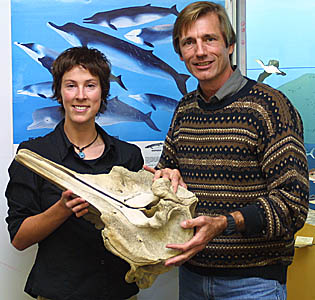 Four whales stranded on the coast of California in the 1970s were identified as Hector’s beaked whale Mesoplodon hectori (Mead 1981 J Mammalogy 62:430). 20 years later mitochondrial DNA analysis revealed these 4 specimens, and a fifth stranded in 1997, to be a new species, designated Perrin’s beaked whale Mesoplodon perrini (Dalebout et al 2002 Marine Mammal Sci 18:577). The presence of a new species was first recognized by researchers compiling a database of mitochondrial DNA to assist in species identification. The formal species description includes diagnostic molecular characters, helping integrate DNA sequence data with classical taxonomy. As emphasized by Rob DeSalle and others, there is a need to interweave phylogeny and classical taxonomy, which can be met by including DNA sequences routinely used for evolutionary analysis as diagnostic characters in species descriptions (DeSalle et al. 2005 Phil Trans Royal Soc B 360:1905).
Four whales stranded on the coast of California in the 1970s were identified as Hector’s beaked whale Mesoplodon hectori (Mead 1981 J Mammalogy 62:430). 20 years later mitochondrial DNA analysis revealed these 4 specimens, and a fifth stranded in 1997, to be a new species, designated Perrin’s beaked whale Mesoplodon perrini (Dalebout et al 2002 Marine Mammal Sci 18:577). The presence of a new species was first recognized by researchers compiling a database of mitochondrial DNA to assist in species identification. The formal species description includes diagnostic molecular characters, helping integrate DNA sequence data with classical taxonomy. As emphasized by Rob DeSalle and others, there is a need to interweave phylogeny and classical taxonomy, which can be met by including DNA sequences routinely used for evolutionary analysis as diagnostic characters in species descriptions (DeSalle et al. 2005 Phil Trans Royal Soc B 360:1905).
I find it remarkable that a species as large as a whale can languish unrecognized in a collection. How many new species lurk in museum drawers awaiting discovery? A comprehensive DNA barcode survey of a tissue collection could be relatively inexpensive, as DNA isolation from tissues is generally simple and and sequencing costs are approaching a $1 a specimen. If whales can hide in museums for 20 years, there must be a multitude of new species already collected that will be uncovered by DNA analysis.
Learning how to apply DNA barcoding to species discovery
In 7 June 2006 Systematics and Biodiversity Andrew Brower examines application of DNA barcodes to identifying and defining new species. His Perspective piece “Problems with DNA barcodes for species delimitation: ‘ten species’ of Astraptes fulgerator reassessed (Lepidoptera: Hesperiidae)” reviews Hebert et al’s 2004 PNAS paper “Ten species in one: DNA barcoding reveals cryptic species in the neotropical skipper butterfly Astraptes fulgerator. My short summary is that we are still learning about how best to use DNA barcodes for identifying new species. In an April 2006 post responding to another worry piece I wrote: “DNA barcoding is a taxonomic tool for a) assigning specimens to known species and b) speeding discovery of new species. More work is needed to determine the best use of DNA barcodes in species discovery.”
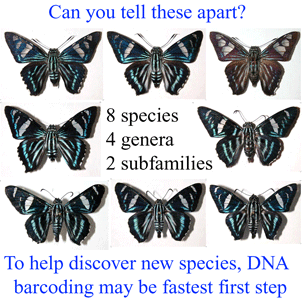 Brower’s article argues about how many Astraptes species are supported by the sequence data, worries about possible consequences of the rise of DNA barcoding, and misses the scientific opportunity to examine this very young species complex with a large set of morphologic, ecologic, and sequence data. He concedes “there are probably at least three species” but declines to put forth what criteria can be used to delimit species. I was surprised to read that the question of whether two sequences “belong to the ‘same species’ is a metaphysical one”.
Brower’s article argues about how many Astraptes species are supported by the sequence data, worries about possible consequences of the rise of DNA barcoding, and misses the scientific opportunity to examine this very young species complex with a large set of morphologic, ecologic, and sequence data. He concedes “there are probably at least three species” but declines to put forth what criteria can be used to delimit species. I was surprised to read that the question of whether two sequences “belong to the ‘same species’ is a metaphysical one”.
A brief summary may be helpful. The PNAS Astraptes paper reports on 25 years of ecological and morphological work on Astraptes fulgerator larva and adults in a conservation area in northwestern Costa Rica. Approximately 40% of the 2,592 A. fulgerator caterpillars collected over this interval were successfully raised to adult; DNA barcodes were derived from the adult specimens. Differences in larval morphology and food plants and in some cases subtle differences in adult morphology suggested the presence of 6-7 cryptic species. When ADDED to this very large natural history knowledge base, DNA barcoding supported these inferences and highlighted another possible 3 or 4 species. The number of individuals sequenced is larger (4-103 per putative species; 7 of 10 with more than 40 specimens sequenced) than in any other single species study I am aware of. Despite the large sample sizes and detailed information on biological co-variation in ecological and morphological traits, Brower seems to read the paper as defining species based on DNA barcodes. According to his own analysis, NJ bootstrap recovered 7 species and cladistic haplotype analysis recovered 8, albeit with low statistical support. The argument over whether some of the putative species are established to be distinct biological entities is important for the Astraptes specialist, but misses the point of how well barcode lineages in the neighbor-joining tree match differences in biology in this VERY YOUNG species complex. To my reading, the findings suggest that if one were starting over, or starting with a unstudied group, using DNA barcoding as a first step would be the fastest way for taxonomists to sort specimens and find new species.
Newsprint
Finnish analyst Lauri Hetemaki documents a powerful example of Dematerialization in the U.S. newsprint market. For more information, see, Hetemäki, L. 2005, Chapter 6.2.2 “The U.S. newsprint market”, pp. 77-80, in ICT and Communication Paper Markets, Chapter 6 in Hetemäki, L. & Nilsson, S. (eds), . IUFRO World Series, Vol. 18, August 2005, Vienna.
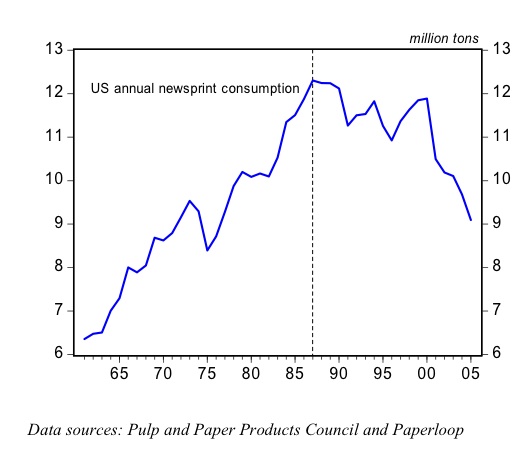
Long Island CoML Talk
Friday 9 June 2006 Jesse presents a progress report on the Census of Marine Life to a Long Island chapter of The Nature Conservancy.
DNA barcoding snake venoms helps toxinologists save lives
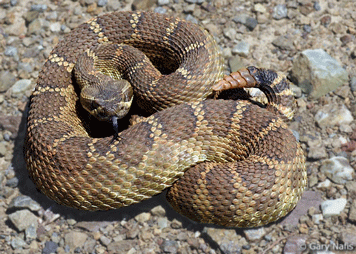 If you hear this sound
If you hear this sound  watch your step–a venomous rattlesnake may be nearby! Prompt administration of the correct antivenom can be life-saving.
watch your step–a venomous rattlesnake may be nearby! Prompt administration of the correct antivenom can be life-saving.
The essential first step in toxinological research is reproducible analyses of venom toxins. However, in December 2005 Toxicon 46: 711-715 Pook and McEwing, University of Wales, report that reproducibility of toxin analyses is commonly compromised by “misidentification of species due to insufficient or changing knowledge of current snake systematics.”
Their article describes a breakthrough in toxinological research: DNA barcoding of dried venoms to provide an accurate, permanent “label” that is independent of future taxonomic changes. This short article is a powerful demonstration of how a standardized approach to identifying species by DNA that uses a public database linked to vouchered specimens, i.e. DNA barcoding, can benefit science and society. While some taxonomists will continue to wring their hands, others may be excited by this work, as it demonstrates how DNA barcoding ADDED TO (and not replacing) standard systematic practice can improve the accessibility and usefulness of ongoing taxonomic work for the larger biological community. I believe this article is enormously important, and I quote here at length.
From the Introduction: “Erroneous or uncertain taxonomy confuses the interpretation of results with respect to intraspecific and interspecific variation. Genuine logistical problems are encountered by non-specialists in taxonomy and snake systematics, in being able to keep up with taxonomic changes. The main hindrances include unresolved taxonomy for some species groups, and new data that change the definition of taxonomic units in others, with the result that the use of systematic information in the toxinological and clinical literature is disorganised. The problem is compounded further by changes in the concept of a particular species, and hence the interpretability of the venom used. Taxonomic confusion, however, has serious implications in snake venom research. The development of effective antivenom treatments and treatment strategies for envenomized patients necessitates a sound taxonomic framework. Accurate clarification of the identity of a given venom is paramount, even after taxonomic revisions involving the species concerned.”
Pook and McEwing “propose a solution to the long-term problem of species identification in toxinological work, utilising mitochondrial haplotypes isolated directly from snake venoms to provide a means of identification that will remain useful even in the face of radical changes in our understanding of the species concerned.”
From the conclusion: “The barcode strategy is dependent on the availablity of known mtDNA haplotype standards against which the sequences being investigated can be compared. Mitochondrial haplotype standards should be gene sequences from snakes of confirmed identity, which have been accessioned to a museum collection as voucher specimens.”
Stressful leisure
The analysis that Jesse Ausubel and Arnulf Gruebler published in 1995 on Working Less and Living Longer: Long-Term Trends in Working Time and Time Budgets is cited in an article on Stressful Leisure in World Magazine, a Christian weekly. We had read the January 2006 report by Mark Aguiar and Eric Hurst on Measuring Trends in Leisure: The Allocation of Time over Five Decades as well as its foil, A Century of Work and Leisure by Valerie Ramey and Neville Francis (June 2005) and recommend both. We continue to believe that changes in total life hours worked merits more attention.
Oklahoma Wind Power
The 17 May New York Times quoted Jesse about windpower. For an exposition of the problem, see “Nuclear and Renewable Heresies” posted 19 March 2005.
Salamanders support standardization
In Barcoding Life, Illustrated we suggested that “standardization typically lowers costs and lifts reliability…and should help accelerate construction of comprehensive, consistent reference library of DNA sequences and development of economical technologies for species identification.” However, some have been doubtful about the benefits of standardization. This reflects in part the balkanized nature of taxonomic science, as most systematists specialize on groups of related organisms and have limited scientific interactions with those studying other groups. Last year Jesse Ausubel and Paul Waggoner outlined some of the concerns raised by the growth of DNA barcoding in Barcoding Worries and Limits. The final item asks whether “it is too soon to standardize on a very few localities”. The salamander paper discussed in last week’s post seems to support this concern, as it implies that the relative rates of evolution of mitochondrial genes differ between animal groups. According to the paper, in salamanders COI evolves much more rapidly than other mitochondrial protein-coding genes.
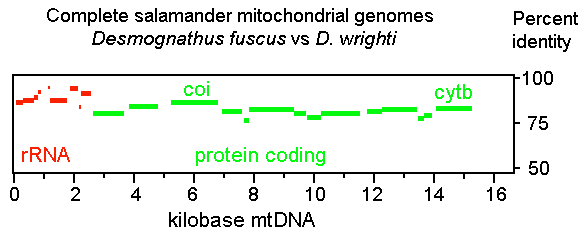
However, as detailed below, my analysis indicates that salamanders are unexceptional in terms of COI differences. I find evolutionary divergences are widely distributed in mitochondrial protein-coding genes and the patterning of these differences is similar in diverse invertebrate and vertebrate organisms, including salamanders. First, I used PipMaker (percent identity plot) to examine the distribution of sequence differences in complete mitochondrial genomes. A representative PipMaker plot, shown above, compares the mitochondrial genomes of 2 plethodontid salamanders, Desmognathus fuscus and D. wrighti, revealing a typical pattern of widely distributed sequence differences. As in most vertebrates, in salamanders COI is slightly LESS divergent (14%) than other protein-coding regions, including cytochrome b (CYTB) (17%).
Second, I compiled differences between closely-related species pairs in CYTB and COI. For historical reasons, CYTB has been the single most common locus used to analyze differences in vertebrate species, and COI has been the single most common single locus for invertebrates. As shown below, these genes show highly correlated differences in deeply divergent lineages of invertebrates and vertebrates, including salamanders.

Species examined include Demospongiae (sponges); Platyhelminthes (tapeworms); Echinodermata (starfish); Arthropoda (ticks; fruit flies; mosquitos; shrimp); Mollusca (octopi; mantis shrimp) Vertebrata (turtles; eels; coelecanths; elephants; wolves; apes; and 5 pairs of congeneric salamanders)
These findings support standardizing on COI as the primary DNA barcode for multicellular animals. As discussed in earlier posts, there will of course be cases in which the primary barcode does not resolve closely-related species and a secondary barcode(s) may be needed.
DNA barcoding identifies invasive pests, appears ready for agricultural application
Pest and invasive species in agricultural crops and shipped goods pose enormous economic and biosecurity threats. Rapidly and reliably identifying pests and invasives in all life stages is likely to be one of the most economically important applications of DNA barcoding. In March 2006 Ann Entomol Soc Am 99: 204 Scheffer, Lewis, and Joshi from the USDA and the Philippine Department of Agriculture apply DNA barcoding to invasive leafminer flies in the Philippines. 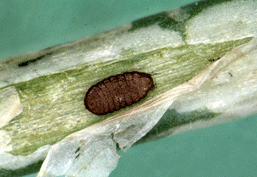 They analyzed 258 specimens from the Philippines and compared these to a database of 307 sequences previously collected from worldwide populations. Bootstrap values for all species were 100%. In addition, a total of 7 distinct clusters
They analyzed 258 specimens from the Philippines and compared these to a database of 307 sequences previously collected from worldwide populations. Bootstrap values for all species were 100%. In addition, a total of 7 distinct clusters
with 98-100% bootstrap support were found in 3 “morphospecies”, suggesting discovery of new species, similar to findings of unrecognized biodiversity in all DNA barcode surveys to date. They conclude “DNA barcoding of economically and medically important species offers a powerful means of rapid identification”.
With DNA barcoding, all can identify this Liriomyza sativae pupae





